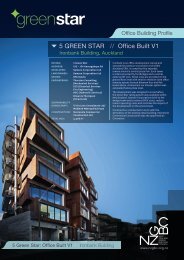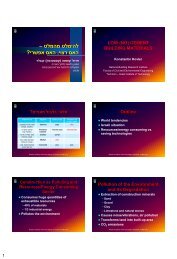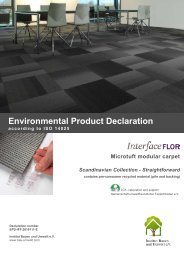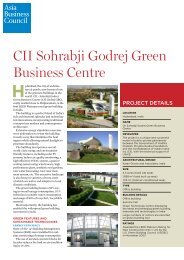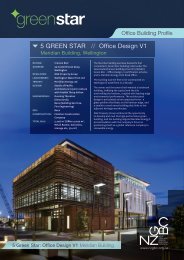Environmental Product Declaration
Environmental Product Declaration
Environmental Product Declaration
You also want an ePaper? Increase the reach of your titles
YUMPU automatically turns print PDFs into web optimized ePapers that Google loves.
<strong>Environmental</strong> <strong>Product</strong> <strong>Declaration</strong><br />
A c c o r d i n g t o I S O 1 4 0 2 5<br />
Ytong ® Autoclaved Aerated Concrete<br />
Made by Xella Baustoffe GmbH<br />
<strong>Declaration</strong> no.<br />
EPD-XEL-2009112-E<br />
Institut Bauen und Umwelt e.V.<br />
(Department for Construction and Environment)<br />
www.bau-umwelt.com
Summary<br />
<strong>Environmental</strong><br />
<strong>Product</strong>-<strong>Declaration</strong><br />
Institut Bauen und Umwelt e.V.<br />
(Department for Construction and Environment)<br />
Execution Body<br />
www.bau-umwelt.com<br />
Xella Baustoffe GmbH<br />
Franz-Haniel-Platz 6-8<br />
D – 47119 Duisburg<br />
<strong>Declaration</strong> Holder<br />
EPD-XEL-2009112-E<br />
Ytong ® Autoclaved Aerated Concrete<br />
This declaration is an <strong>Environmental</strong> <strong>Product</strong> <strong>Declaration</strong> according to ISO 14025 and describes the<br />
environmental performance of the above-mentioned building products. It is intended to promote the<br />
development of environmental and health compatible construction.<br />
All relevant environmental data is disclosed in this validated declaration.<br />
This EPD is based on the product category rules ‘PCR Autoclaved Aerated Concrete: 11-2004’<br />
This validated declaration authorises the holder to bear the official stamp of the IBU. It only applies to<br />
the above-mentioned products for three years from the date of issue. The declaration holder is liable<br />
for the information and evidence on which the declaration is based.<br />
<strong>Declaration</strong> Number<br />
Declared building<br />
products<br />
Validity<br />
This declaration is complete and contains in detail:<br />
- <strong>Product</strong> definition and physical data<br />
- Information about raw materials and origin<br />
- Specifications on manufacturing the product<br />
- References for product processing<br />
- Information on product in use, singular effects and end of life<br />
- LCA results<br />
- Evidence and verifications<br />
Content of the <strong>Declaration</strong><br />
February 16 th , 2009<br />
Date of Issue<br />
Signatures<br />
Prof. Dr.-Ing. Horst J. Bossenmayer (IBU Chairman)<br />
This declaration and the rules it is based on, have been verified by the Independent Advisory Board<br />
(SVA) according to ISO 14025.<br />
Verification of the<br />
<strong>Declaration</strong><br />
Signatures<br />
Prof. Dr.-Ing. Hans-Wolf Reinhardt (Chairman of the SVA)<br />
Dr. Eva Schmincke (Verifier appointed by the SVA)
Summary<br />
<strong>Environmental</strong><br />
<strong>Product</strong>-<strong>Declaration</strong><br />
The products mentioned are non-reinforced building blocks in various formats made of autoclaved<br />
aerated concrete. AAC belongs to the porous steam-cured light-weight concrete group.<br />
<strong>Product</strong> Description<br />
Non-reinforced building blocks for brick-laid, monolithic, load-bearing and non-load-bearing walls. As<br />
intended, no direct contact with groundwater is possible, because aerated concrete is always coated<br />
and there is no direct contact with soil.<br />
Range of Application<br />
The Lifecycle Assessment (LCA) was carried out according to DIN ISO 14040 et sqq. Specific data by<br />
Xella from 2004 was used as a database, along with average data for the raw materials used, such as<br />
cement, quick lime, anhydrite or aluminium powder and paste. The LCA was carried out for the<br />
manufacturing phase of aerated concrete for gross density categories 400 kg/m 3 (P2 0.40) and 500<br />
kg/m 3 (P4 0.50) taking into account all the background information, like raw material exploitation and<br />
transports („cradle to gate“).<br />
Scope of the LCA<br />
Comparison with other products is only permissible in the context of comparable use within the<br />
building.<br />
Ytong ® - Autoclaved Aerated Concrete P2 0,40 and P4 0,50<br />
Results of the LCA<br />
Indicator Unit per m³ P2 0.40 P4 0.50<br />
Primary energy, non-renewable [MJ] 1427 1683<br />
Primary energy, renewable [MJ] 74 76<br />
Global Warming Potential (GWP 100) [kg CO 2-eqv.] 179 217<br />
Ozone Depletion Potential (ODP) [kg R11-eqv.] 10.0 * 10 -6 10.9 * 10 -6<br />
Acidification Potential (AP) [kg SO 2-eqv.] 0.263 0.285<br />
Eutrophication Potential (EP) [kg PO 4-eqv.] 0.044 0.049<br />
Photochemical Ozone Creation<br />
Potential (POCP)<br />
[kg Ethene-eqv.] 0.038 0.042<br />
Issued by: PE International GmbH, Leinfelden-Echterdingen<br />
The following evidence and verifications are also described in the <strong>Environmental</strong> <strong>Product</strong> <strong>Declaration</strong><br />
Evidence and Verifications<br />
• Radioactivity Measurement of radionuclides<br />
• Leaching out properties<br />
According to class 1 of the Technical Instructions on Waste<br />
from Human Settlements
<strong>Environmental</strong> <strong>Product</strong> <strong>Declaration</strong><br />
Ytong ® - Autoclaved Aerated Concrete Page 4<br />
<strong>Product</strong> group: Autoclaved Aerated Concrete Issued<br />
<strong>Declaration</strong> holder: Xella Baustoffe GmbH 05-02-2009<br />
<strong>Declaration</strong> number: EPD-XEL-2009112-E<br />
0 <strong>Product</strong> definition<br />
<strong>Product</strong><br />
definition<br />
Range of<br />
application<br />
<strong>Product</strong><br />
standard/<br />
approval<br />
Quality control<br />
Geometric data<br />
The products mentioned are non-reinforced building blocks in various formats made<br />
of autoclaved aerated concrete. AAC belongs to the porous steam-cured light-weight<br />
concrete group.<br />
Non-reinforced building blocks for brick-laid, monolithic, load-bearing and non-loadbearing<br />
walls. As intended, direct contact with ground water is avoided thanks to the<br />
constructional features.<br />
DIN 4165, DIN 4166, DIN EN 771 part 4; general approval by the building authorities<br />
of the German Institute for Structural Engineering (DIBt).<br />
Supervision by the manufacturer and externally according to the above-mentioned<br />
standards/general approval by building authorities, QM system according to DIN EN<br />
9001.<br />
Measurements according to DIN 4165, DIN 4166, DIN 4223 and general approval by<br />
the building authorities.<br />
Physical data Gross density: ρ = 0.3 – 0.8 kg/dm³<br />
Thermal<br />
insulation<br />
Pressure resistance:<br />
Tensile strength:<br />
β = 2.0 – 10.0 N/mm²<br />
β = 0.24 – 1.2 N/mm²<br />
Bending tensile strength: β = 0.44 – 2.2 N/mm²<br />
E-Module:<br />
750 - 3250 N/mm²<br />
Steam-diffusion resistance figure µ according to DIN 4108 T4: 5/10<br />
Equilibrium moisture content at 73.4 °F, 80 % air humidity: < 4 M-%<br />
Shrinkage according to DIN EN 680 < 0.2 mm/m<br />
Heat conductivity:<br />
according to DIN 12664, λ R = 0.09 – 0.18 W/m* K<br />
Table 1: Specific data for various gross density categories<br />
Ytong ® - Aerated Autoclaved Concrete<br />
Density category PPW 2 PPW 4 PPW 6 Dimension<br />
Gross density<br />
category value<br />
Average of<br />
compressive<br />
strength value<br />
Calculation value of<br />
heat conductivity λ R<br />
according to<br />
approval<br />
0.35 0.40 0.50 0.55 0.60 0.65 -<br />
≥ 2.5 ≥ 5.0 ≥ 7.5 N/mm²<br />
0.09 0.10<br />
0.12<br />
0.13<br />
0.14 0.16<br />
0.16/<br />
0.18<br />
Sound proofing Sound proofing R’ w,R = 26.1 log m‘ – 8.4 [dB] according to DIN 4109<br />
W/(mK)<br />
Fire protection Depending on the formation of the wall, fire resistance categories up to F 180<br />
according to DIN 4102 are attainable.
<strong>Environmental</strong> <strong>Product</strong> <strong>Declaration</strong><br />
Ytong ® - Autoclaved Aerated Concrete Page 5<br />
<strong>Product</strong> group: Autoclaved Aerated Concrete Issued<br />
<strong>Declaration</strong> holder: Xella Baustoffe GmbH 05-02-2009<br />
<strong>Declaration</strong> number: EPD-XEL-2009112-E<br />
1 Raw materials<br />
Raw materials<br />
primary products<br />
Sand<br />
Cement<br />
Quick lime<br />
Anhydride/plaster<br />
Aluminium<br />
60 – 70 M-%<br />
15 – 30 M-%<br />
10 – 20 M-%<br />
2 – 5 M-%<br />
0.05 – 0.1 M-%<br />
Auxiliary<br />
substances/<br />
additives<br />
Material<br />
explanation<br />
Raw material<br />
extraction and<br />
origin<br />
Availability of<br />
raw materials<br />
In addition, 50 – 75 M-% water is used (in relation to the solid substances).<br />
Mould oil<br />
Sand: The used sand is a natural raw material that contains natural minor<br />
components and traces of minerals, along with the main mineral quartz (SiO 2 ). It is a<br />
significant raw material for the hydrothermal reaction during steam-curing.<br />
Cement: Acc. to DIN EN 197-1; cement is used as a bonding agent and is mainly<br />
produced using limestone marl or a mixture of limestone and clay. The natural raw<br />
materials are burned and subsequently ground.<br />
Quick lime: Acc. to DIN EN 459; quick lime is used as a bonding agent and is<br />
produced by burning natural limestone.<br />
Anhydride / plaster: Acc. to DIN 1168; the sulphate carrier used is utilized to<br />
influence the solidification period of the AAC and either comes from natural deposits<br />
or is manufactured artificially.<br />
Aluminium: Aluminium powder or paste is used as a pore-forming agent. It reacts to<br />
the release of hydrogen gas in the alkaline milieu, which forms pores and escapes<br />
once the expanding process is concluded.<br />
Water: The presence of water is the basis for the hydraulic reaction of the bonding<br />
agent. Moreover, water is necessary to produce a homogenous suspension.<br />
Mould oil: Mould oil is the release agent to separate the autoclaved aerated concrete<br />
mass from the mould. PAH is used – free mineral oils with addition of long-chain<br />
additives to increase viscosity. This prevents any run-off in the mould and enables<br />
economical use.<br />
The sand is from sand pits within immediate proximity to the AAC plant. Any other<br />
raw materials (apart from the slight amounts of aluminium powder or paste) come<br />
from a surrounding area of at most 200 kilometres from the plant.<br />
Mineral building products such s autoclaved aerated concrete mainly consist of<br />
mineral raw materials. There is no shortage of resources.<br />
2 Manufacturing the building product<br />
Manufacturing<br />
the building<br />
product<br />
The ground quartz sand is mixed with chalk, cement and AAC recycling material that<br />
has been reduced to small pieces, water and aluminium powder or paste, in a mixer,<br />
until it becomes a watery suspension. It is then poured into a casting mould. The<br />
water extinguishes the chalk if there is any heat development. The aluminium reacts<br />
in an alkaline milieu. Thus, gaseous hydrogen is formed which creates pores in the<br />
mass and escapes without leaving any residue. The pores usually have a diameter of<br />
0.02 – 0.06 inches and are filled exclusively with air. After setting once, semisolid raw<br />
blocks are created, from which the autoclaved aerated concrete building components<br />
are then cut with high precision.
<strong>Environmental</strong> <strong>Product</strong> <strong>Declaration</strong><br />
Ytong ® - Autoclaved Aerated Concrete Page 6<br />
<strong>Product</strong> group: Autoclaved Aerated Concrete Issued<br />
<strong>Declaration</strong> holder: Xella Baustoffe GmbH 05-02-2009<br />
<strong>Declaration</strong> number: EPD-XEL-2009112-E<br />
Health protection<br />
(during<br />
production)<br />
<strong>Environmental</strong><br />
protection<br />
production<br />
The formation of the final qualities of the building component occurs during the<br />
subsequent steam-curing over 5-12 hours at approximately 374 °F with approximately<br />
12 bar pressure in steam pressure kettles or autoclaves, as they are called. The used<br />
substances create calcium silicate hydrate, which corresponds to the naturally<br />
occurring mineral tobermorite. The reaction of the material is complete when removed<br />
from the autoclave. Therefore, the reaction does not take as long as the hardening of<br />
concrete. Once the steaming process is complete, the steam is used for other<br />
autoclave cycles. The condensation accumulating is used as process water. Thereby,<br />
energy is saved and harm to the environment due to hot exhaust steam and<br />
wastewater is avoided. AAC building blocks are then piled onto wooden palettes and<br />
shrink-wrapped in polyethylene wrap.<br />
The body of rules and regulations of the employers’ mutual insurance association<br />
applies. No special measures need to be taken for the protection of employees’<br />
health.<br />
The general legal foundations apply. No special measures need to be taken for the<br />
protection of the environment.<br />
3 Working with the building product<br />
Processing<br />
recommendations<br />
Job safety /<br />
environmental<br />
protection<br />
Residual material<br />
/ packaging<br />
AAC building blocks are worked with manually. Lifting gear is necessary with building<br />
components with a mass over 25 kg. Building blocks are cut using band saws or by<br />
hand with carbide metal saws, as this only generates coarse dust particles rather<br />
than fine dust. High-speed tools, such as abrasive cutting-off machines are<br />
inapplicable for working with AAC, as they release fine dust articles.<br />
The AAC building blocks are cemented to each other or to other standardised<br />
building materials using thin-bed mortar according to DIN 1053, part 1; in special<br />
cases, normal or light mortar (11 kg mortar / m³) can also be used. The AAC building<br />
blocks can be plastered, coated or painted. Alternatively, it is possible to line with<br />
small-sized parts or to affix facing shell according to DIN 1053, part 1.<br />
To assess mortars and coatings, the corresponding IBU-declarations must be taken<br />
into account.<br />
The body of rules and regulations of the employers’ mutual insurance association<br />
applies. The thin-bed mortars used when working with autoclaved aerated concrete<br />
are mineral mortars and hardly contain any organic substances, apart from<br />
methylcellulose.<br />
No special measures need to be taken for the protection of the environment when<br />
working with the building material.<br />
When selecting any additional auxiliary materials necessary, make sure that the<br />
quality does not negatively influence the environmental sustainability of the building<br />
products described.<br />
Any packaging, palettes or remaining AAC accumulated on the building site must be<br />
collected. The polyethylene shrink-wrap is recyclable. Any PE sheets that have not<br />
been soiled (care must be taken that the collection is not mixed).<br />
4 Building product in use<br />
Constituents<br />
As explained in point 2 “Manufacturing the building product”, autoclaved aerated<br />
concrete mainly consists of tobermorite, a natural mineral. It also contains not reacted<br />
raw components, predominantly coarse quartz, if applicable carbonates. The pores<br />
are completely filled with air.
<strong>Environmental</strong> <strong>Product</strong> <strong>Declaration</strong><br />
Ytong ® - Autoclaved Aerated Concrete Page 7<br />
<strong>Product</strong> group: Autoclaved Aerated Concrete Issued<br />
<strong>Declaration</strong> holder: Xella Baustoffe GmbH 05-02-2009<br />
<strong>Declaration</strong> number: EPD-XEL-2009112-E<br />
<strong>Environmental</strong><br />
health effects<br />
Long term<br />
durability<br />
AAC does not emit any contaminants such as VOCs.<br />
The natural ionising emission of AAC products is extremely low and harmless in<br />
terms of health.<br />
AAC does not change once it leaves the autoclaves. When used as intended, it is<br />
boundlessly stable.<br />
5 Singular effects<br />
Fire<br />
Water<br />
No toxic gases or vapours are released in case of a fire. The products referred to fulfil<br />
the requirements of building product category A1, “non-flammable” according to DIN<br />
4102.<br />
When exposed to water (e.g. floods), AAC has a slight alkaline reaction. However, no<br />
substances are washed out which could be harmful to the water.<br />
6 End of life phase<br />
Reuse and<br />
downuse<br />
Recycling and<br />
downcycling<br />
Disposal<br />
AAC outlasts the service life of the buildings it is used for. This means that when this<br />
type of building is dismantled, the materials can be used again with no concerns<br />
regarding their durability. The reuse of assembly components made from AAC has<br />
been and is still put into practice. Up till now, walled AAC building blocks have hardly<br />
ever been reused.<br />
Unmixed AAC surpluses can be returned to the AAC manufacturers and recycled.<br />
This has been done for decades for production residues. This material is either<br />
processed to granules or is added to AAC mixture as a substitute for sand.<br />
The capacity of AAC to be landfilled according to class 1 of the Technical Instruction<br />
Waste From Humans Settlements is guaranteed.<br />
7 Life cycle assessment<br />
7.1 <strong>Product</strong>ion of Ytong ®<br />
Declared unit<br />
System<br />
boundaries<br />
Cut-off criteria<br />
Transports<br />
Period under<br />
consideration<br />
The declared unit is 1 m³ Ytong ® -AAC non-reinforced from gross density class P2<br />
0.40 (gross density 380 kg/m³) and P4 0.50 (485 kg/m³). Ytong ® -AAC gross density<br />
class 0.40 is the most produced AAC by Xella, with a a percentage of over 40%,<br />
followed by gross density class 0.50 at 30%.<br />
The system boundaries selected cover the production of Ytong ® -AAC from raw<br />
material extraction to the finished packaged product at the factory gate (cradle to<br />
gate).<br />
All material flows that enter the system and are bigger than 1% of their entire mass or<br />
contribute more than 1% to the primary energy consumption, are taken into<br />
consideration on the input side.<br />
All material flows that exit the system and whose environmental impact makes up<br />
more than 1% of the total impact in an impact category considered, are covered on<br />
the output page.<br />
All transportation of raw and auxiliary materials used was considered in the<br />
assessment.<br />
The data for the production of the building materials analysed (Ytong ® -AAC) are<br />
based on the year 2004.<br />
Background data The data base GaBi 4 / GaBi 2003/ was used to calculate the energy generated and<br />
the transport. In detail, this covers:
<strong>Environmental</strong> <strong>Product</strong> <strong>Declaration</strong><br />
Ytong ® - Autoclaved Aerated Concrete Page 8<br />
<strong>Product</strong> group: Autoclaved Aerated Concrete Issued<br />
<strong>Declaration</strong> holder: Xella Baustoffe GmbH 05-02-2009<br />
<strong>Declaration</strong> number: EPD-XEL-2009112-E<br />
Data quality<br />
Allocation<br />
• The compositions of all used substances (preliminary products)<br />
• Expenditure for production (energy, waste, emissions)<br />
• Preliminary products and energy supply<br />
• Transport and packaging of raw materials and preliminary products<br />
The data collection for the building<br />
materials analysed was carried out in<br />
the plants directly. The major part the<br />
data for the upstream chain comes<br />
from industrial sources which were<br />
compiled under consistent boundaries<br />
in terms of time and methods.<br />
Emphasis was put on obtaining a<br />
thorough collection of environmentally<br />
relevant material and energy flows.<br />
The data can therefore be considered<br />
to be of a very high quality.<br />
Allocations (the classification of the<br />
environmental pollutants of a process<br />
on several products) were carried out<br />
according to mass for the by-products.<br />
<strong>Product</strong>ion<br />
process<br />
The process steps taken into<br />
consideration in the life cycle inventory<br />
analysis are shown in figure 1:<br />
Figure 1: Flow diagram of the production process<br />
of Ytong®-AAC<br />
(Source: Ytong®/Xella, modified)<br />
7.2 Description of the balances and analyses<br />
Life Cycle<br />
Inventory (LCI)<br />
Table 2 shows the primary energy consumption (renewable and non-renewable) for<br />
the production of 1 m³ Ytong ® -AAC for both gross density categories P2 and P4.<br />
Table 2:<br />
Primary Energy Consumption for the <strong>Product</strong>ion of 1 m³ Ytong ® -AAC<br />
Ytong ® - AAC P2 0.40 and P4 0.50<br />
Indicator<br />
Primary energy,<br />
non-renewable<br />
Primary energy,<br />
renewable<br />
Unit per<br />
m³<br />
P2 0.40 P4 0.50<br />
[MJ] 1427.0 1683.3<br />
[MJ] 74.3 75.6<br />
Closer examination of the required energy (figure 2) for the production of both gross<br />
density classes of Ytong ® -AAC reveals that natural gas is used as the major primary<br />
energy source, followed by coal, lignite, crude oil and uranium. The high proportion of<br />
natural gas in the primary energy consumption is due to the use of steam for steamcuring.
<strong>Environmental</strong> <strong>Product</strong> <strong>Declaration</strong><br />
Ytong ® - Autoclaved Aerated Concrete Page 9<br />
<strong>Product</strong> group: Autoclaved Aerated Concrete Issued<br />
<strong>Declaration</strong> holder: Xella Baustoffe GmbH 05-02-2009<br />
<strong>Declaration</strong> number: EPD-XEL-2009112-E<br />
100%<br />
80%<br />
Primärenergieverbrauch Breakdown of primary energy nach Energieträgern<br />
consumption<br />
5% 4%<br />
Renewables<br />
Regenerierbare energetische<br />
Ressourcen<br />
32% 35%<br />
Natural Erdgas gas<br />
60%<br />
40%<br />
20%<br />
0%<br />
14% 13%<br />
17% 16%<br />
20% 21%<br />
12% 11%<br />
P2 0.40 0,40 P4 0.50 0,50<br />
Crude Erdöl oil<br />
Lignite Braunkohle<br />
Steinkohle Hard coal<br />
Nuclear Uran<br />
Figure 2:<br />
Breakdown of the consumption of non-renewable and renewable primary energy<br />
of 1 m³ Ytong ® -AAC<br />
In addition, approx. 67 MJ/m³ AAC energy from secondary fuels (used oil, used tyres<br />
etc.) are used for P2 0.40 and approx. 63 MJ/m³ for P4 0.50.<br />
Most of the material resources used are necessary to produce the ingredients:<br />
limestone (225 kg/m³ AAC for P2; 273 kg/m³ for P4), sand/gravel (233 kg/m³ AAC for<br />
P2; 304 kg/m³ for P4), plaster / anhydride (21 kg/m³ AAC for P2; 19.5 kg/m³ for P4),<br />
clay (4.6 kg/m³ AAC for P2; 4.4 kg/m³ for P4) and bauxite (2.6 kg/m³ AAC for P2 and<br />
P4).<br />
The analysis of the waste accumulated for the production of 1 m³ Ytong ® -AAC in both<br />
gross density classes is presented separately for the 3 fractions overburden and<br />
tailings, domestic-type commercial waste, and hazardous waste (table 3).<br />
Table 3:<br />
Waste accumulated during the production of 1 m³ Ytong ® -AAC<br />
Ytong ® - AAC P2 0.40 and P4 0.50<br />
Indicator P2 0.40 P4 0.50<br />
Overburden / tailings [kg/m³] 315.4 367.30<br />
Domestic-type commercial<br />
waste [kg/m³]<br />
2.78 2.78<br />
Hazardous waste [kg/m³] 0.45 0.51<br />
Overburden and tailings mainly occur due to coal and lignite extraction which are<br />
generally used for the production of the bonding agents (cement and chalk).<br />
Impact<br />
assessment<br />
The following figure shows the comparative contributions of raw materials,<br />
production, transport and packaging for 1 m³ Ytong ® -AAC P2 0.40 and P4 0.50 for<br />
the impact categories Global Warming Potential (GWP), Ozone Depletion Potential<br />
(ODP), Acidification Potential (AP), Eutrophication Potential (EP), Photochemical<br />
Ozone Creation Potential (POCP).<br />
In all environmental impacts, the highest contributions by far can be apportioned to<br />
the extraction and/or production of raw materials, at least 45% each. The second
<strong>Environmental</strong> <strong>Product</strong> <strong>Declaration</strong><br />
Ytong ® - Autoclaved Aerated Concrete Page 10<br />
<strong>Product</strong> group: Autoclaved Aerated Concrete Issued<br />
<strong>Declaration</strong> holder: Xella Baustoffe GmbH 05-02-2009<br />
<strong>Declaration</strong> number: EPD-XEL-2009112-E<br />
highest, but with a significantly lower proportion in all impact categories, is the<br />
production of autoclaved aerated concrete (including electricity and thermal energy).<br />
Packaging and transportation of the raw materials are of secondary importance.<br />
Global Treibhauspotential<br />
Potential<br />
Warming<br />
100%<br />
Ozone Ozonabbaupotential<br />
Depletion<br />
Potential<br />
Versauerungspotential<br />
Acidification<br />
Potential<br />
Eutrophication<br />
Eutrophierungspotential<br />
Creation potential<br />
Photochemical Sommersmog-<br />
Ozone<br />
Potential<br />
Potential<br />
80%<br />
60%<br />
40%<br />
Packaging Verpackung<br />
20%<br />
Transport<br />
<strong>Product</strong>ion Produktion<br />
Raw Rohstoffe materials<br />
0%<br />
.<br />
P2 0,40<br />
.<br />
P4 0,50<br />
.<br />
P2 0,40<br />
.<br />
P4 0,50<br />
.<br />
P2 0,40<br />
.<br />
P4 0,50<br />
.<br />
P2 0,40<br />
.<br />
P4 0,50<br />
.<br />
P2 0,40<br />
.<br />
P4 0,50<br />
Figure 3:<br />
Comparative contributions of individual categories to the environmental impacts<br />
of 1 m³ of Ytong ® -AAC P2 0.40 and P4 0.50<br />
The absolute contributions of the production of 1 m³ Ytong ® -AAC P2 0.40 and<br />
P4 0.50 to the individual environmental impacts are shown in table 4:<br />
Tabelle 4: Absolute contributions of the production of Ytong ® -AAC P2 0.40 and P4 0.50<br />
to the individual environmental impacts per cubic meter.<br />
Ytong ® - AAC P2 0.40 and P4 0.50<br />
Impact Category Unit P2 0.40 P4 0.40<br />
Global Warming Potential kg CO 2-eqv. 178.7 217.1<br />
Ozone Depletion Potential kg R11-eqv. 9.99 * 10 -6 10.9 * 10 -6<br />
Acidification Potential kg SO 2-eqv. 0.263 0.285<br />
Eutrophication Potential kg Phosphate-eqv. 0.044 0.049<br />
Photochemical Ozone<br />
Creation Potential (POCP)<br />
kg Ethene-eqv. 0.038 0.042<br />
The production of the bonding agents cement and chalk make the largest contribution<br />
by far to all impact categories by far. Together, they contribute over 70% to the global<br />
warming potential and over 50% to the acidification potential for both gross density<br />
classes. With both gross density classes, the production contributes to the<br />
eutrophication potential in particular with approx. 25%. Electricity and thermal energy<br />
with at least 15% each have an influence on the individual impact categories which is<br />
by no means negligible. Additional materials or transport and packaging are of<br />
secondary importance.
<strong>Environmental</strong> <strong>Product</strong> <strong>Declaration</strong><br />
Ytong ® - Autoclaved Aerated Concrete Page 11<br />
<strong>Product</strong> group: Autoclaved Aerated Concrete Issued<br />
<strong>Declaration</strong> holder: Xella Baustoffe GmbH 05-02-2009<br />
<strong>Declaration</strong> number: EPD-XEL-2009112-E<br />
8 Evidence<br />
A manufacturer declaration exists, according to which the composition of the basic<br />
materials, the production process and the product features of the Xella building<br />
components referred to, have not changed since the evidence named in the following<br />
was issued. The evidence is therefore completely valid.<br />
Radioactivity All mineral substances contain slight levels of natural radioactive materials, e. g.<br />
certain isotopes of radium and thorium. Ionising radiation can cause an increase in<br />
the natural pollution in unventilated buildings, in particular the radioactive inert gas<br />
radon. In terms of “healthy living”, the potential inhalation of radioactive inert gases<br />
should be limited to a harmless level. This means that the level of radium-226 and<br />
thorium-232 (or thorium-228) cannot exceed a total of 260 Bq/kg (7nCi/kg) and 130<br />
Bq/kg (3.5nCi/kg) each. Should the standard values be exceeded, it is necessary to<br />
assess the radon-exhalation rates, whereby the following values cannot be exceeded:<br />
Radon-222 < 5.5 Bq/m²h, Radon-220 (thoron) < 1,850 Bq/m²h. As the results of the<br />
following analysis show, the natural radiation of the products referred to is extremely<br />
low and not harmful to health.<br />
Test point: BfS, Bundesamt für Strahlenschutz (Federal Bureau for Radiation<br />
Prevention), D-38201 Salzgitter.<br />
Leaching<br />
Result: c Ra 226 + c Th 232 ≤ 40 Bq/kg. The standard values < 260 Bq/kg for the total of<br />
the radionuclides and < 130 Bq/kg for every individual radionuclide are included. As<br />
the measured level of radionuclides lies far below the standard value, the assessment<br />
of the exhalation rates of radon is not necessary.<br />
The leaching out of autoclaved aerated concrete is significant for the assessment of<br />
its post-use environmental impact once landfilled.<br />
Test point: Prüfamt für bituminöse Baustoffe und Kunststoffe der Technischen<br />
Universität München (Testing Department for Bituminous Construction Materials and<br />
Synthetic Materials of the Technical University Munich).<br />
Result: All criteria for the landfilling according to class 1 of the Technical Instructions<br />
on Waste from Human Settlements are fulfilled.<br />
9 PCR document and verification<br />
10 References<br />
This declaration is based on the <strong>Product</strong> Category Rules – Autoclaved Aerated<br />
Concrete<br />
Review of the PCR-Documents by the Committee of Experts.<br />
Chairman of the Committee of Experts: Prof. Dr.-Ing. Hans-Wolf Reinhardt (University<br />
of Stuttgart, IWB)<br />
Independent verification of the declaration according to ISO 14025:<br />
internal external<br />
Validation of the declaration: Dr. Eva Schminke<br />
/GaBi 2003/<br />
GaBi 4: Software und Datenbank zur Ganzheitlichen Bilanzierung. IKP, Universität
<strong>Environmental</strong> <strong>Product</strong> <strong>Declaration</strong><br />
Ytong ® - Autoclaved Aerated Concrete Page 12<br />
<strong>Product</strong> group: Autoclaved Aerated Concrete Issued<br />
<strong>Declaration</strong> holder: Xella Baustoffe GmbH 05-02-2009<br />
<strong>Declaration</strong> number: EPD-XEL-2009112-E<br />
/ISO 14040/<br />
/BfS 2008/<br />
Stuttgart und PE Europe GmbH, Leinfelden-Echterdingen, April 2003.<br />
DIN EN ISO 14040: Umweltmanagement - Ökobilanz - Prinzipien und allgemeine<br />
Anforderungen, Deutsche Fassung EN ISO 14040:1997.<br />
Gehrke, K. Hoffmann, B., Schkade, U., Schmidt, V., Wichterey, K.: Natürliche<br />
Radioaktivität in Baumaterialien und die daraus resultierende Strahlenexposition -<br />
Zwischenbericht; Bundesamt für Strahlenschutz, Berlin 2008, 37 S.
<strong>Environmental</strong> <strong>Product</strong> <strong>Declaration</strong><br />
Ytong ® - Autoclaved Aerated Concrete Page 13<br />
<strong>Product</strong> group: Autoclaved Aerated Concrete Issued<br />
<strong>Declaration</strong> holder: Xella Baustoffe GmbH 05-02-2009<br />
<strong>Declaration</strong> number: EPD-XEL-2009112-E<br />
Publisher:<br />
Institut Bauen und Umwelt e.V.<br />
(before: Arbeitsgemeinschaft Umweltverträgliches Bauprodukt e.V., AUB)<br />
Rheinufer 108<br />
53639 Königswinter<br />
Tel.: 02223 296679-0<br />
Fax: 02223 296679-1<br />
Email:<br />
info@bau-umwelt.com<br />
Internet: www.bau-umwelt.com<br />
AAC Forum<br />
Chairman: Dr. Hartmut Walther<br />
Layout:<br />
PE International GmbH<br />
Picture Credits:<br />
Xella Baustoffe GmbH




